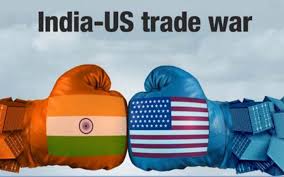
Modi’s Defiant Stand Against America’s Tariff Assault
The relationship between the United States and India has reached a critical juncture as President Donald Trump has imposed unprecedented 50% tariffs on Indian goods, marking the most aggressive trade deficit action against a strategic ally in decades. This escalation has transformed what was once considered a flourishing partnership into a high-stakes economic confrontation, with Prime Minister Narendra Modi taking an uncompromising stance to protect Indian interests despite mounting American pressure.
The current crisis began when Trump initially announced a 25% “reciprocal” tariff on Indian imports on July 31, 2025, which came into effect on August 7. However, the situation dramatically deteriorated when Trump announced an additional 25% tariff on August 6, bringing the total levy to 50% — one of the highest tariff rates imposed by the US on any country globally. This additional tariff, effective from August 27, specifically targets India’s continued purchase of Russian oil, which Trump’s administration claims is “fueling the Russian war machine”.
The Energy Security Dilemma: Russian Oil at the Heart of Tensions
India’s energy security strategy has become the primary flashpoint in this trade war. Since Russia’s invasion of Ukraine in February 2022, India has dramatically increased its Russian oil imports, with the share rising from a meager 2% in 2021 to 39% by the end of 2023. This shift was driven primarily by economic pragmatism — Indian refiners saved approximately $2.7 billion by importing Russian crude rather than Iraqi oil in the first nine months of 2023 alone.
The scale of India’s Russian energy imports is staggering. In 2024, India’s fossil fuel imports from Russia reached $53 billion, making it the second-largest purchaser of Russian crude after China. India purchased 38% of Russia’s crude exports in May, June, and July 2025, contributing significantly to Moscow’s war chest. The Trump administration views this as directly undermining Western sanctions and providing critical financial support for Russia’s military operations in Ukraine.
India’s Ambassador to Russia, Vinay Kumar, has firmly defended New Delhi’s position, stating that “Government will continue taking measures which will protect the national interest of the country” and that “Indian companies will continue buying from wherever they get the best deal”. This defiant stance underscores India’s commitment to strategic autonomy in energy procurement, regardless of American pressure.
Modi’s Agricultural Red Line: Protecting Farmers Above All Trade Deficit
Prime Minister Modi’s response to Trump’s tariff escalation has been swift and uncompromising. Speaking at the MS Swaminathan Centenary International Conference, Modi declared that “India will never compromise with the interests of its farmers, livestock holders, and fishermen”. Without directly naming Trump or the United States, Modi made his position crystal clear: “I know that I will have to pay a huge price for this personally, but I am ready. India is ready for it”.
This declaration represents more than just economic policy — it reflects the political imperatives that drive Indian trade negotiations. Agriculture employs 46% of India’s workforce and sustains 42% of the population yet contributes less than 20% of GDP. The average farming household earns only Rs 13,661 per month, with a mere Rs 4,476 from actual farming. Opening India’s agricultural markets to subsidized American products would devastate these vulnerable livelihoods.
The Trump administration’s demands have included unrestricted access to India’s agricultural markets, including dairy, fisheries, and genetically modified products. American negotiators have pushed for India to lower tariffs on farm products such as corn, soybeans, apples, cotton, almonds, and ethanol. However, Modi’s firm stance protecting farmers has become a political red line that the Indian government refuses to cross, even at the cost of economic retaliation from Washington.
Economic Warfare: The Scope and Impact of Tariffs
The 50% tariff structure represents a complex layering of duties that makes Indian goods prohibitively expensive in the American market. The total comprises a baseline 10% duty, a 25% reciprocal tariff announced in April 2025, and an additional 25% tariff targeting Russian oil purchases. This places India alongside Brazil as facing the highest tariff rates among US trading partners, significantly higher than China’s 30% or Vietnam’s 20-40%.
Approximately 55% of India’s $86.5 billion in annual exports to the US face these punitive tariffs. The sectors most vulnerable include textiles, gems and jewelry, leather products, marine products, chemicals, and auto components. However, critical exemptions remain for pharmaceuticals, semiconductors, energy resources, and critical minerals, protecting about $30 billion worth of Indian exports from the tariff escalation.
The pharmaceutical sector, representing $9.8 billion in exports, has emerged as a major winner with its continued exemption status. This is strategically significant as India supplies 50% of the US generic drug market, making American healthcare heavily dependent on Indian pharmaceutical production. Similarly, smartphone exports worth $10.9 billion remain protected under electronics exemptions.
Strategic Implications: BRICS, Dollar Dominance, and Geopolitical Realignment
The tariff war extends far beyond bilateral trade disputes, touching on fundamental questions of global economic architecture. Trump’s administration has explicitly cited India’s BRICS membership as a concern, viewing the bloc as “anti-dollar” and a challenge to American economic hegemony. India’s participation in BRICS initiatives, including discussions on alternative payment systems and trade mechanisms that could bypass the dollar-dominated SWIFT system, has raised alarms in Washington.
The BRICS Cross-Border Payments Initiative, which India has endorsed, represents a direct challenge to the US financial system’s global dominance. This proposed payment system would allow member countries to conduct international transactions in their own currencies, reducing dependence on the dollar and potentially undermining America’s ability to impose economic sanctions.
China’s Cross-Border Interbank Payment System (CIPS) and Russia’s System for Transfer of Financial Messages (SPFS) already provide alternatives to SWIFT, and the expansion of such systems could fundamentally alter global finance. The BRICS nations, representing 45% of the world’s population and 35% of global GDP, are actively working to reduce their collective dependence on Western financial infrastructure.
The Broader Context: Strategic Partnership Under Strain
The current trade tensions represent a dramatic shift from the trajectory of US-India relations under previous administrations. During the Biden era (2021-2024), the relationship was characterized by strategic partnerships and institutional dialogue. Key achievements included the Initiative on Critical and Emerging Technology (iCET), launched in May 2022, which deepened cooperation in AI, quantum computing, semiconductors, and advanced telecommunications.
The two countries had successfully resolved all seven pending WTO disputes by 2024, including long-standing disagreements over steel and aluminum tariffs, renewable energy subsidies, and agricultural trade. Bilateral trade had reached a record high of over $200 billion in 2023, demonstrating the potential for expanded economic cooperation.
However, Trump’s return to office has fundamentally altered this dynamic. The “America First” approach prioritizes addressing the $45.7 billion Trump india tariffs deficit over strategic partnership considerations. Trump has repeatedly criticized India’s trade practices as “obnoxious” and labeled the country a “Tariff King” for its protective duties.
Defense Cooperation: A Stabilizing Force Amid Trade Tensions
Despite the escalating trade war, the defense partnership between the two countries remains robust, providing a potential stabilizing influence. The US-India Major Defense Partnership, designated in 2016, has facilitated significant military cooperation. India has integrated numerous US-origin defense systems, including C-130J Super Hercules aircraft, P-8I Poseidon maritime patrol aircraft, Apache helicopters, and MQ-9B drones.
The recently announced Autonomous Systems Industry Alliance (ASIA) and new procurement plan for Javelin anti-tank missiles and Stryker infantry combat vehicles demonstrate continued defense collaboration. The ten-year Framework for US-India Major Defense Partnership set to be signed in 2025 could provide institutional continuity despite trade disputes.
Market Response and Economic Projections
The economic impact of the 50% tariffs is already being felt across Indian industries. Shrimp farmers in Andhra Pradesh, who have thrived for decades as India became the top supplier to the US market, are now considering switching to fish farming or other occupations as export rates have dropped by 20%. The immediate effect on exporters has been severe, with most indicating they cannot absorb tariff increases beyond 10-15%.
Economic projections suggest significant consequences if the tariffs remain in place. According to IDFC First Bank’s chief economist, a 50% duty could drag down India’s FY26 GDP growth by 0.4%. Japanese brokerage Nomura warned that such tariffs would resemble “a trade embargo,” potentially reducing affected exports by 20-30% and pushing growth below 6% this year.
However, the impact is somewhat limited by the scope of affected trade. While the tariffs target India’s largest export market, they are expected to impact only 4.8% of India’s total global exports. This provides some insulation for the Indian economy, though specific sectors and regions face severe challenges.
Global Precedent: Secondary Sanctions and Future Threats
Trump’s approach to India represents part of a broader strategy of secondary sanctions designed to isolate Russia economically. The president has warned of “a lot more secondary sanctions” targeting countries that continue trading with Russia. This approach extends beyond India to potentially affect other major Russian trading partners, including China, Turkey, and various European nations that maintain economic ties with Moscow.
The secondary sanctions model leverages America’s dominance in global financial systems and the ubiquity of the dollar in international trade. However, this approach carries significant risks, potentially pushing allied countries to develop alternative systems and reducing American influence over time. The effectiveness of such measures depends heavily on the credibility of threats and the absence of viable alternatives for targeted countries.
Agricultural Vulnerability and Food Security
The agricultural dimension of the trade dispute reveals the vulnerability of specific farming communities to international trade policies. India’s marine products exports to the US, valued at $248 million in 2024, represent the largest category of agricultural exports. These come primarily from fishing communities rather than traditional crop farmers, but their livelihoods are now directly threatened by the tariff escalation.
Spice exports, particularly from Kerala, face similar challenges, affecting perhaps fewer than one million farmers directly connected to US exports out of India’s 146 million total farmers. This relatively small direct impact explains why Modi’s government feels confident in its ability to protect affected communities through targeted support measures rather than capitulating to American demands.
Technology and Innovation: Strategic Decoupling Risks
The trade war threatens to undermine the technology partnership that has been a cornerstone of US-India strategic cooperation. The US-India Initiative on Critical and Emerging Technology (iCET) has facilitated collaboration in semiconductors, artificial intelligence, and space technology. However, sustained trade tensions could prompt both countries to seek alternative partners for critical technology development.
India’s growing role as a global manufacturing hub, particularly in electronics and pharmaceuticals, makes it an attractive alternative to China for American companies seeking supply chain diversification. The current tariff regime, however, undermines this potential by making Indian production less competitive in the US market. This could ultimately harm American interests by reducing options for reducing dependence on Chinese manufacturing.
Regional and Global Implications
The US-India trade war has broader implications for regional stability and global economic governance. India’s potential closer alignment with China and Russia, as suggested by recent diplomatic developments, could fundamentally alter the balance of power in the Indo-Pacific region. The Shanghai Cooperation Organization (SCO) and BRICS platforms provide institutional frameworks for such realignment.
The World Trade Organization (WTO) remains largely sidelined in this dispute, reflecting the broader crisis in multilateral trade governance. India has expressed interest in restoring the WTO’s dispute settlement mechanism, which has been paralyzed since 2019 due to US blocking of Appellate Body appointments. However, the current bilateral approach to trade disputes suggests little immediate prospect for renewed multilateral engagement.
Looking Forward: Potential Pathways to Resolution
Despite the current tensions, both countries have strategic incentives to find a resolution. The US needs India as a counterweight to China in the Indo-Pacific, while India requires American technology and investment for its economic development goals. The Mission 500 initiative, aimed at reaching $500 billion in bilateral trade by 2030, demonstrates the potential for expanded economic cooperation.
Potential compromise solutions could include graduated tariff reductions tied to specific Indian commitments on market access, alternative arrangements for Russian oil purchases that satisfy American concerns while preserving Indian energy security, or sector-specific agreements that protect the most vulnerable communities in both countries. The continued exemption of pharmaceuticals and electronics suggests that pragmatic considerations can override political tensions when strategic interests align.
Conclusion: A Test of Strategic Maturity
The current crisis represents a fundamental test of the maturity and resilience of the US-India strategic partnership. Both countries face domestic political pressures that limit their flexibility — Trump’s commitment to reducing trade deficits and Modi’s obligation to protect farmers and maintain strategic autonomy. However, the broader geopolitical context, including the shared challenge of China’s rise and the need for technological cooperation, provides compelling reasons for finding a mutually acceptable resolution.
The outcome of this trade war will likely shape not only bilateral relations but also the broader architecture of global economic governance. Success in navigating these tensions could demonstrate the possibility of managing complex relationships between major powers in an increasingly multipolar world. Failure, however, could accelerate the fragmentation of the global economy into competing blocs, undermining the prosperity and stability that both countries ultimately seek to preserve.
The stakes extend far beyond trade statistics or tariff rates. They involve fundamental questions about sovereignty, economic security, and the rules that will govern international commerce in the 21st century. As both leaders navigate these treacherous waters, the choices they make will reverberate far beyond their own borders, potentially determining whether the world moves toward greater cooperation or deeper fragmentation in addressing shared challenges.


